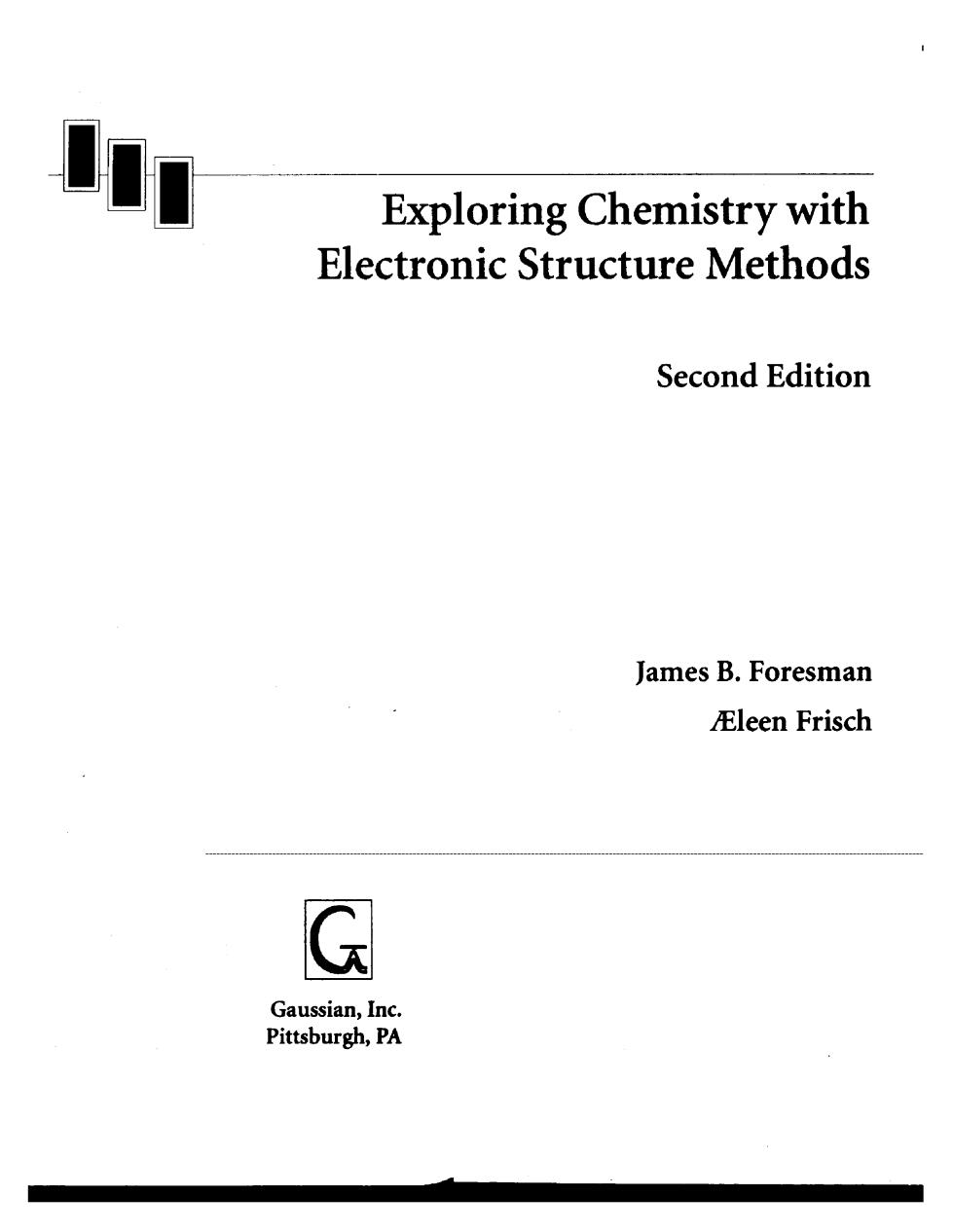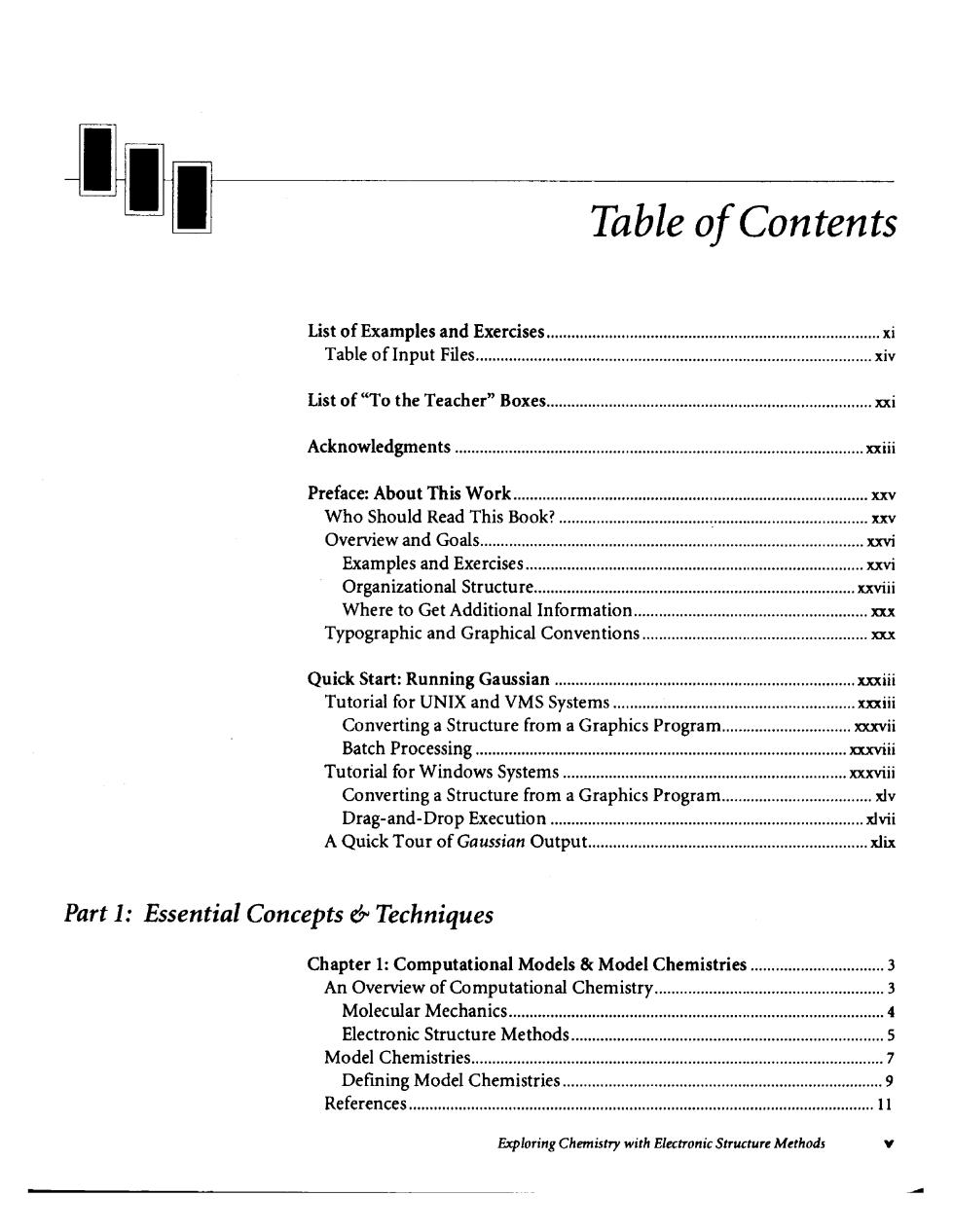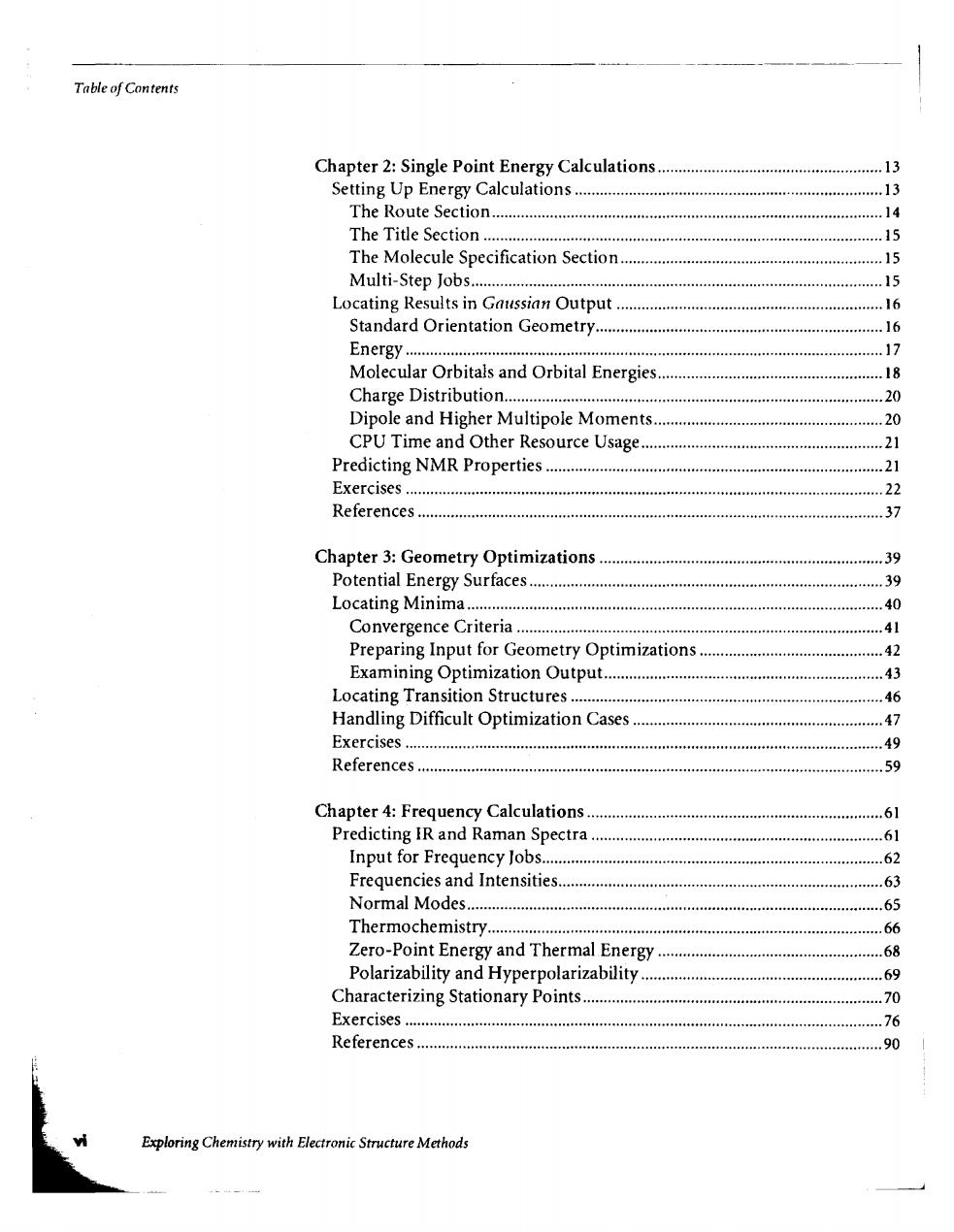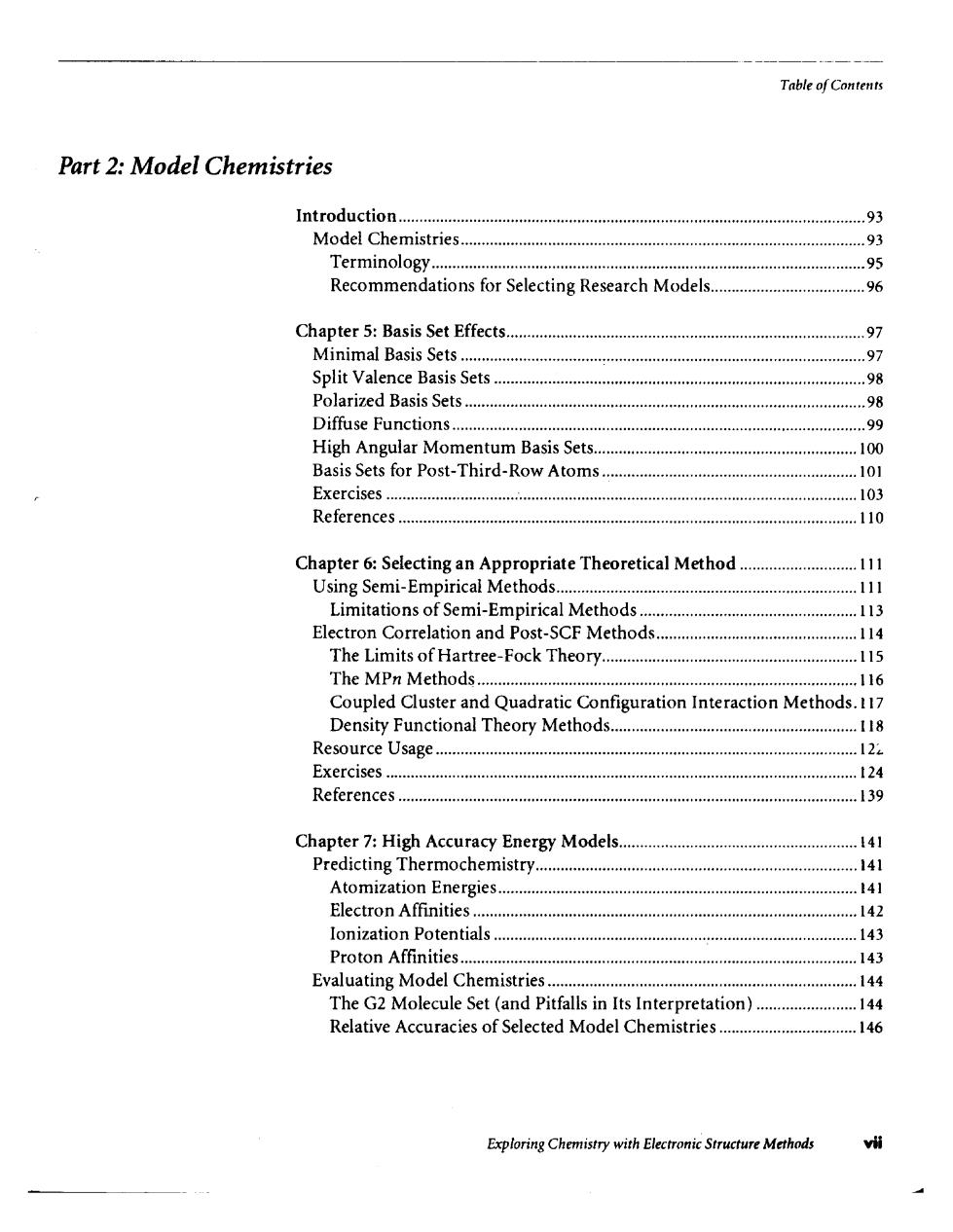
4i1 Exploring Chemistry with Electronic Structure Methods Second Edition James B.Foresman Eleen Frisch G Gaussian,Inc. Pittsburgh,PA
III~----- Exploring Chelllistry with Electronic Structure Methods Second Edition James B. Foresman lEleen Frisch Gaussian, Inc. Pittsburgh, PA

1 Quick Topic Finder Accuracies of Model Chemistries …146,157 Atomic Charges… .194 CASSCF Method… .228 Complete Basis Set Methods.154 Density Functional Theory.............118 Excited States… .213 Frequency Calculations............... …62 G2 Calculations.… ..150 Hyperfine Coupling Constants ........ .136 IRC Calculations… 173 Isodesmic Reactions. 181 Methods Accuracies Compared …146,157 Relative Costs… …122 Model Chemistries Selection Recommendations .96 Molecular Orbitals .18 NMR Properties 21,53,104 Optimizations Petforing Advanced Techniques...... ) Characterizing Stationary Points..70 Locating Transition Structures .46 Potential Energy Surface Scans ........ .171 Reaction Path Following …173 Resource Requirements.......22 Scale Factors for Frequencies/zpEs...64 SN2 Reactions .208 Solvent Effects .237 Stability Calculations …34 Thermochemistry ......... 66,141 Transition Structure Optimizations …46 Exploring Chemistry with Electronic Structure Methods 讯
D Quick Topic Finder Accuracies of Model Chemistries 146, 157 Atomic Charges 194 CASSCF Method 228 Complete Basis Set Methods 154 Density Functional Theory 118 Excited States 213 Frequency Calculations 62 G2 Calculations 150 Hyperfine Coupling Constants 136 IRC Calculations 173 Isodesmic Reactions 181 Methods Accuracies Compared 146, 157 Relative Costs 122 Model Chemistries Selection Recommendations 96 Molecular Orbitals 18 NMR Properties 21, 53, 104 Optimizations Performing 42 Advanced Techniques 47 Characterizing Stationary Points 70 Locating Transition Structures 46 Potential Energy Surface Scans 171 Reaction Path Following 173 Resource Requirements 122 Scale Factors for Frequencies/ZPEs 64 SN2 Reactions 208 Solvent Effects 237 Stability Calculations , 34 Thermochemistry 66, 141 Transition Structure Optimizations 46 Exploring Chemistry with Electronic Structure Methods iii

lii Table of Contents List of Examples and Exercises............. ....xi Table of Input Files..v List of To the Teacher Boxes..... Preface:About This Work Who Should Read This Book? ........xv Overview and Goals.......... Examples and Exercises. .......xxvi Organizational Structure................ ..xViii Where to Get Additional Information.... …X Typographic and Graphical Conventions............. ....x Quick Start:Running Gaussian... ,X双ii Tutorial for UNIX and VMS Systems............ …xii Converting a Structure from a Graphics Program...........xxxvii Batch Processing… …xii Tutorial for Windows Systems............. ........viji Converting a Structure from a Graphics Program...v Drag-and-Drop Execution.............. .........vii A Quick Tour of Gaussian Output....... ....xlix Part 1:Essential Concepts Techniques Chapter 1:Computational Models Model Chemistries3 An Overview of Computational Chemistry.......3 Molecular Mechanics.............. 4 Electronic Structure Methods................... .5 Model Chemistries. Defining Model Chemistries..9 Exploring Chemistry with Electronic Structure Methods
111r------ Table ofContents List of Examples and Exercises xi Table ofInput Files xiv List of "To the Teacher" Boxes xxi Acknowledgments xxiii Preface: About This Work xxv Who Should Read This Book? xxv Overview and Goals xxvi Exampies and Exercises xxvi Organizational Structure xxviii Where to Get Additional Information xxx Typographic and Graphical Conventions xxx Quick Start: Running Gaussian xxxiii Tutorial for UNIX and VMS Systems xxxiii Converting a Structure from a Graphics Program xxxvii B hP . ... atc rocesslng XXXVlIl Tutorial for Windows Systems xxxviii Converting a Structure from a Graphics Program xlv Drag-and-Drop Execution xlvii A Quick Tour ofGaussian Output. xlix Part 1: Essential Concepts & Techniques Chapter 1: Computational Models & Model Chemistries 3 An Overview ofComputational Chemistry 3 Molecular Mechanics 4 Electronic Structure Methods 5 Model Chemistries 7 Defining Model Chemistries 9 References 11 Exploring Chemistry with Electronic Structure Methods Y

Table of Contents Chapter 2:Single Point Energy Calculations...................13 Setting Up Energy Calculations............ .13 The Route Section14 The Title Section................. .15 The Molecule Specification Section.15 Multi-Step Jobs.… .15 Locating Results in Gaussian Output......6 Standard Orientation Geometry....16 Molecular Orbitals and Orbital Energies............18 Charge Distribation...20 Dipole and Higher Multipole Moments...........................................2o CPU Time and Other Resource Usage.... Predicting NMR Properties................ .21 Exercises …22 References… 37 Chapter 3:Geometry Optimizations....... 39 Potential Energy Surfaces......39 L0 cating Minima… 40 Convergence Criteria..... Preparing Input for Geometry Optimizations................................42 Examining Optimization Output.............. 43 Locating Transition Structures .............. 4.46 Handling Difficult Optimization Cases...4. Exercises… …49 Chapter 4:Frequency Calculations61 Predicting IR and Raman Spectra.61 Input for Frequency Jobs....6 Frequencies and Intensities..........63 Norhal Modes65 Therm0 chemistry.… .66 Zero-point Energy andThermal Energy68 Polarizability and Hyperpolarizability............... 69 Characterizing Stationary Points...70 Exercises.... .76 Exploring Chemistry with Electronic Structure Methods
Table ofContents '~---'--------'--~- 1 Chapter 2: Single Point Energy Calculations 13 Setting Up Energy Calculations 13 The Route Section 14 The Titie Section 15 The Molecule Specification Section 15 Multi-Step Jobs 15 Locating Results in Gaussian Output 16 Standard Orientation Geometry 16 Energy 17 Molecular Orbitals and Orbital Energies 18 Charge Distribution 20 Dipole and Higher Multipole Moments 20 CPU Time and Other Resource Usage 21 Predicting NMR Properties 21 Exercises 22 References 37 Chapter 3: Geometry Optimizations 39 Potential Energy Surfaces 39 Locating Min ima 40 Convergence Criteria 41 Preparing Input for Geometry Optimizations 42 E .. 0 ... 0 xamlnlng ptlrnlzatlon utput 43 Locating Transition Structures 46 Handling Difficult Optimization Cases 47 Exercises 49 References 59 Chapter 4: Frequency Calculations 61 Predicting IR and Raman Spectra 61 Input for Frequency Jobs 62 Frequencies and Intensities 63 Normal Modes 65 Thermochemistry 66 Zero-Point Energy and ThermalEnergy 68 Polarizability and Hyperpolarizability 69 Characterizing Stationary Points 70 Exercises 76 References 90 Exploring Chemistry with Electronic Structure Methods

Table of Contents Part 2:Model Chemistries IntToductio93 Model Chemistries....93 Termin0l0gy .95 Recommendations for Selecting Research Models...................96 Chapter 5:Basis Set Effects.................. 97 Minimal Basis Sets....97 Split Valence Basis Sets. .98 Polarized Basis Sets...98 Diffuse Functions. .99 High Angular Momentum Basis Sets......100 Basis Sets for Post-Third-Row Atoms..............101 BKeTCiSeS103 References.. 110 Chapter 6:Selecting an Appropriate Theoretical Method11 Using Semi-EmpiricalMethods.111 Limitations of Semi-Empirical Methods.......13 Electron Correlation and Post-SCF Methods................................114 The Limits of Hartree-Fock Theory.115 The MPn Methods......16 Coupled Cluster and Quadratic Configuration Interaction Methods.117 Density Functional Theory Methods...........118 Resource Usage… |22 Exercises. 124 References… …139 Chapter 7:High Accuracy Energy Models. 141 Predicting Thermochemistry............. .141 Atomization Energies........... 141 Electron Affinities....... …142 Ionization Potentials143 ProtOn Affinities....143 Evaluating Model Chemistries... .144 The G2 Molecule Set (and Pitfalls in Its Interpretation).....................144 Relative Accuracies of Selected Model Chemistries............................146 Exploring Chemistry with Electronic Structure Methods vi州
----------------------_._--------------------_.- Table ofContetl'S Part 2: Model Chemistries Introduction 93 Model Chemistries 93 Terminology 95 Recommendations for Selecting Research Models 96 Chapter 5: Basis Set Effects 97 Minimal Basis Sets 97 Split Valence Basis Sets 98 Polarized Basis Sets 98 Diffuse Functions 99 High Angular Momentum Basis Sets 100 Basis Sets for Post-Third-Row Atoms 101 Exercises 103 References 110 Chapter 6: Selecting an Appropriate Theoretical Method III Using Semi-Empirical Methods III Limitations ofSemi-Empirical Methods 113 Electron Correlation and Post-SCF Methods 114 The Limits ofHartree-Fock Theory 115 The MPn Methods 116 Coupled Cluster and Quadratic Configuration Interaction Methods.117 Density Functional Theory Methods 118 Resource Usage 12:.- Exercises 124 References 139 Chapter 7: High Accuracy Energy Models 141 Predicting Thermochemistry 141 Atomization Energies 141 Electron Affmities 142 Ionization Potentials 143 Proton Affinities 143 Evaluating Model Chemistries 144 The G2 Molecule Set (and Pitfalls in Its Interpretation) 144 Relative Accuracies of Selected Model Chemistries 146 Exploring Chemistry with Electronic Structure Methods vii